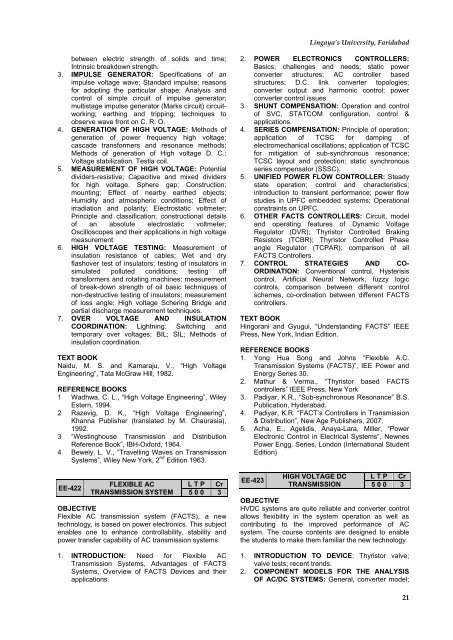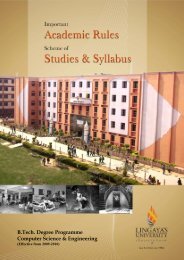Electrical and Electronics - Lingaya's University
Electrical and Electronics - Lingaya's University
Electrical and Electronics - Lingaya's University
You also want an ePaper? Increase the reach of your titles
YUMPU automatically turns print PDFs into web optimized ePapers that Google loves.
Lingaya’s <strong>University</strong>, Faridabadbetween electric strength of solids <strong>and</strong> time;Intrinsic breakdown strength.3. IMPULSE GENERATOR: Specifications of animpulse voltage wave; St<strong>and</strong>ard impulse; reasonsfor adopting the particular shape; Analysis <strong>and</strong>control of simple circuit of impulse generator;multistage impulse generator (Marks circuit) circuitworking;earthing <strong>and</strong> tripping; techniques toobserve wave front on C. R. O.4. GENERATION OF HIGH VOLTAGE: Methods ofgeneration of power frequency high voltage;cascade transformers <strong>and</strong> resonance methods;Methods of generation of High voltage D. C.;Voltage stabilization. Testla coil.5. MEASUREMENT OF HIGH VOLTAGE: Potentialdividers-resistive; Capacitive <strong>and</strong> mixed dividersfor high voltage. Sphere gap; Construction;mounting; Effect of nearby earthed objects;Humidity <strong>and</strong> atmospheric conditions; Effect ofirradiation <strong>and</strong> polarity; Electrostatic voltmeter;Principle <strong>and</strong> classification; constructional detailsof an absolute electrostatic voltmeter;Oscilloscopes <strong>and</strong> their applications in high voltagemeasurement.6. HIGH VOLTAGE TESTING: Measurement ofinsulation resistance of cables; Wet <strong>and</strong> dryflashover test of insulators; testing of insulators insimulated polluted conditions; testing offtransformers <strong>and</strong> rotating machines; measurementof break-down strength of oil basic techniques ofnon-destructive testing of insulators; measurementof loss angle; High voltage Schering Bridge <strong>and</strong>partial discharge measurement techniques.7. OVER VOLTAGE AND INSULATIONCOORDINATION: Lightning: Switching <strong>and</strong>temporary over voltages; BIL; SIL; Methods ofinsulation coordination.TEXT BOOKNaidu, M. S. <strong>and</strong> Kamaraju, V., ―High VoltageEngineering‖, Tata McGraw Hill, 1982.REFERENCE BOOKS1 Wadhwa, C. L., ―High Voltage Engineering‖, WileyEstern, 1994.2 Razevig, D. K., ―High Voltage Engineering‖,Khanna Publisher (translated by M. Chaurasia),1992.3 ―Westinghouse Transmission <strong>and</strong> DistributionReference Book‖, IBH-Oxford, 1964.4 Bewely, L. V., ―Travelling Waves on TransmissionSystems‖, Wiley New York, 2 nd Edition 1963.EE-422FLEXIBLE ACTRANSMISSION SYSTEML T P Cr5 0 0 3OBJECTIVEFlexible AC transmission system (FACTS), a newtechnology, is based on power electronics. This subjectenables one to enhance controllability, stability <strong>and</strong>power transfer capability of AC transmission systems.1. INTRODUCTION: Need for Flexible ACTransmission Systems, Advantages of FACTSSystems, Overview of FACTS Devices <strong>and</strong> theirapplications.2. POWER ELECTRONICS CONTROLLERS:Basics; challenges <strong>and</strong> needs; static powerconverter structures; AC controller basedstructures; D.C. link converter topologies;converter output <strong>and</strong> harmonic control; powerconverter control issues.3. SHUNT COMPENSATION: Operation <strong>and</strong> controlof SVC, STATCOM configuration, control &applications.4. SERIES COMPENSATION: Principle of operation;application of TCSC for damping ofelectromechanical oscillations; application of TCSCfor mitigation of sub-synchronous resonance;TCSC layout <strong>and</strong> protection; static synchronousseries compensator (SSSC).5. UNIFIED POWER FLOW CONTROLLER: Steadystate operation; control <strong>and</strong> characteristics;introduction to transient performance; power flowstudies in UPFC embedded systems; Operationalconstraints on UPFC.6. OTHER FACTS CONTROLLERS: Circuit, model<strong>and</strong> operating features of Dynamic VoltageRegulator (DVR); Thyristor Controlled BrakingResistors (TCBR); Thyristor Controlled Phaseangle Regulator (TCPAR); comparison of allFACTS Controllers.7. CONTROL STRATEGIES AND CO-ORDINATION: Conventional control, Hysterisiscontrol, Artificial Neural Network, fuzzy logiccontrols, comparison between different controlschemes, co-ordination between different FACTScontrollers.TEXT BOOKHingorani <strong>and</strong> Gyugui, ―Underst<strong>and</strong>ing FACTS‖ IEEEPress, New York, Indian Edition.REFERENCE BOOKS1. Yong Hua Song <strong>and</strong> Johns ―Flexible A.C.Transmission Systems (FACTS)‖, IEE Power <strong>and</strong>Energy Series 30.2. Mathur & Verma., ―Thyristor based FACTScontrollers‖ IEEE Press, New York3. Padiyar, K.R., ―Sub-synchronous Resonance‖ B.S.Publication, Hyderabad.4. Padiyar, K.R. ―FACT‘s Controllers in Transmission& Distribution‖, New Age Publishers, 2007.5. Acha, E., Agelidis, Anaya-Lara, Miller, ―PowerElectronic Control in <strong>Electrical</strong> Systems‖, NewnesPower Engg. Series, London (International StudentEdition)EE-423HIGH VOLTAGE DCTRANSMISSIONL T P Cr5 0 0 3OBJECTIVEHVDC systems are quite reliable <strong>and</strong> converter controlallows flexibility in the system operation as well ascontributing to the improved performance of ACsystem. The course contents are designed to enablethe students to make them familiar the new technology.1. INTRODUCTION TO DEVICE: Thyristor valve;valve tests; recent trends.2. COMPONENT MODELS FOR THE ANALYSISOF AC/DC SYSTEMS: General, converter model;21
















